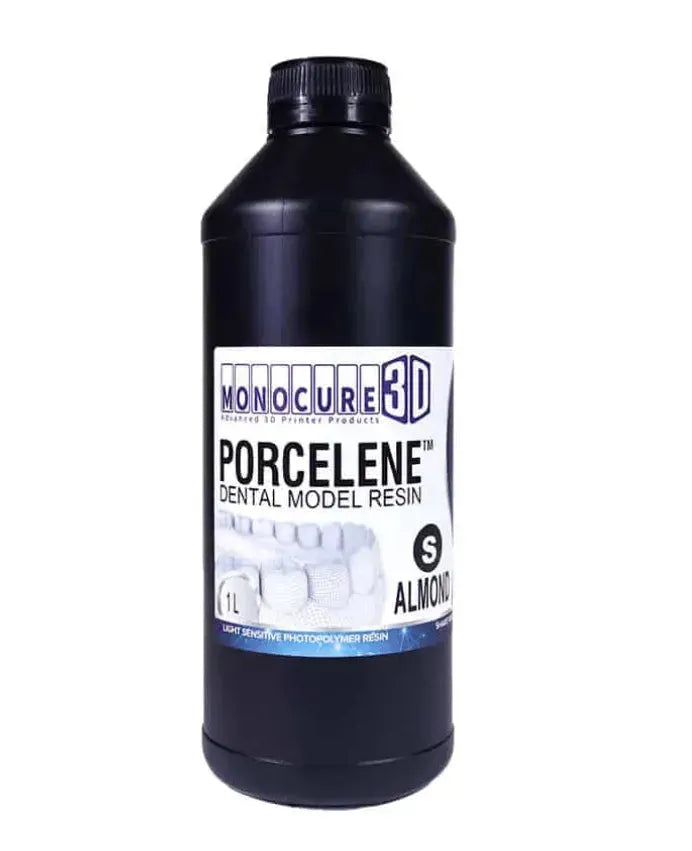MONOCURE PORCELENE™ DENTAL RESIN (S) -1000 ML - ALMOND
MONOCURE PORCELENE™ DENTAL RESIN (S) -1000 ML - ALMOND
Couldn't load pickup availability



Designed to work with all open system MSLA 3D printers, PORCELENE™ Dental Model Resin enables high precision, dimensional stability and a matte matte finish with a chalk-like texture throughout the processing of 3D printed dental models. The delicate balance between toughness, hardness and flexibility optimizes it for all processes, including diagnostic, implant and orthodontic models, crown and bridge prototypes. Its low flex properties also make it suitable for vacuum forming aligner designs. NB. Monocure 3D Dental Model Resin is not approved for intraoral use.
Choose formula R if you have a 3D printer that uses an LCD screen and an array of LEDs (MSLA) to create the layers. For DLP printers that use a projector module, choose formula (S) for best results.
Characteristics:
- Formula S if the printer uses a projector (DLP) module to create layers.
- Formula R if you have a 3D printer that uses an LCD screen and LED array (MSLA) to create the layers.
PORCELENE™ SINGLE-CURE DENTAL RESIN
Discover Porcelene™, Monocure3D's newest and newest dental formula. Our search began with the biggest and best dental labs. We wanted to find out the properties that were most important to lab technicians and dentists who needed the models and to people who used 3D printers. We needed color, viscosity, consistency, odor, hardness, rigidity, accuracy, heat resistance, no warping or shrinkage, opacity, surface finish, compatibility, speed, duration and ease of cleaning for optimal results. With each new resin sample sent to our dental lab technicians and selected dentists for field testing, the feedback we received from each sample tested was invaluable. Combining the experience of our chemists, analytical skills and systematic approach, PORCELENE™ resin was born.
Designed to work with all open system DLP and MSLA 3D printers, PORCELENE™ Dental Model Resin enables high precision, dimensional stability and a matte matte finish with a chalk-like texture throughout the processing of printed dental models. 3D. The delicate balance between toughness, hardness and flexibility optimizes it for all processes, including diagnostic, implant and orthodontic models, crown and bridge prototypes. Its low flex properties also make it suitable for vacuum forming aligner designs. NB. Monocure 3D Dental Model Resin is not approved for intraoral use.
Our quality control procedures follow ISO 9001 guidelines to ensure batch-to-batch consistency in every bottle. We call it the "set and forget" methodology, which means you only have to dial in the resin once, so it's as simple as pour and stamp, giving you more time to focus on what's important. The unique low viscosity formula means fewer misprints on the coldest days, allowing for consistent results all year round.
DENTAL PORCELENE™ resin is very versatile and can be printed with layer heights between 5 microns and 100 microns. For best results, 3D models should always be designed solid. If digging is necessary, make sure drainage holes are included to remove any trapped resin.
Always print large flat areas at one corner to facilitate warping of the print due to adhesion to the FEP film. To assist with unsupported areas, be sure to use solid, well-placed supports. We recommend adding a "Wait after printing" setting of 1-2 seconds to allow the material to cool after curing before you begin lifting the build bed. (Not all slicers have this setting, check with your software vendor.) Use a calibration template, to program your printer with our resin.
WHICH PORCELENE™ FORMULA FOR MY PRINTER?
This new resin is available in two formulas:
- Formula S if the printer uses a projector (DLP) module to create layers.
- Formula R if you have a 3D printer that uses an LCD screen and LED array (MSLA) to create the layers.
Shipping and Warranty
Shipping and Warranty
All products available in stock will be delivered with an average timing of 24/48 hours.
Italy warranty with dedicated consulting support, contact us!
Share
-
Free shipping, return in 14 days *.
DisclosureFree express shipping for orders over € 499.
* For return terms and conditions, please visit our returns and refunds policy.
-
-
Are you a professional or a company?
Contact usYou can ask us for an invoice for your purchases! All the prices of our products already include VAT.
-
Do you have the teacher's card?
Contact usProceed with checkout and select "Teacher's Card" as the payment method. Requests?


